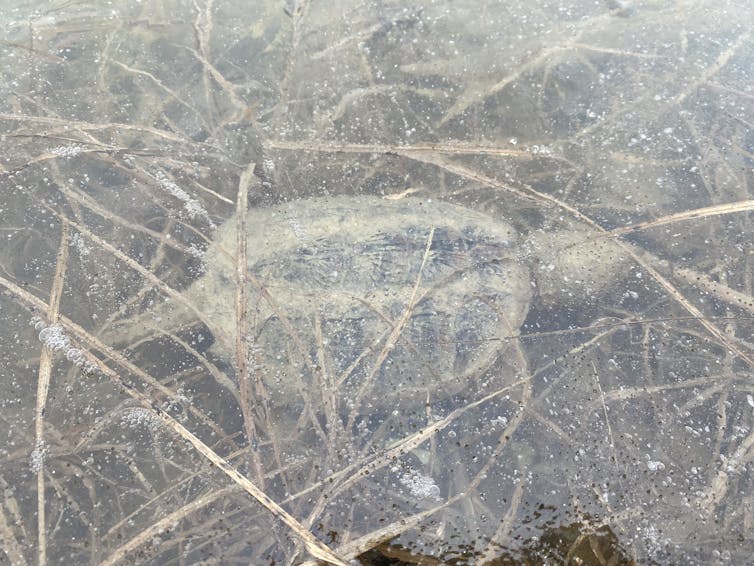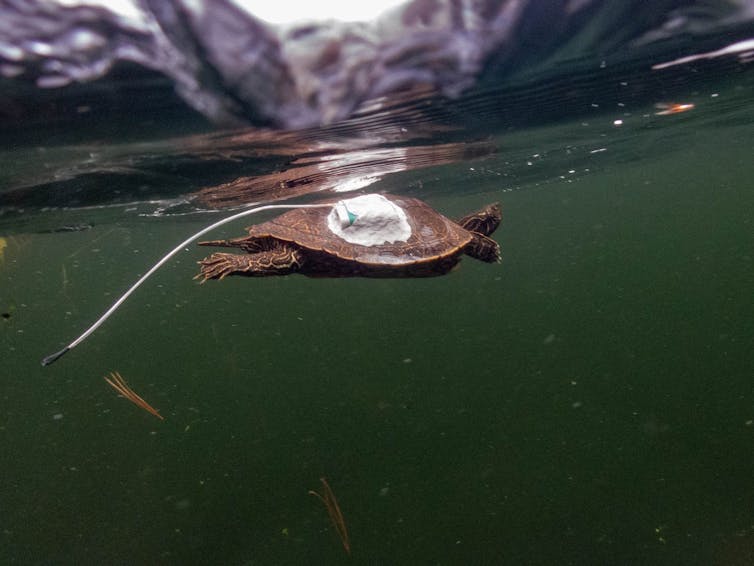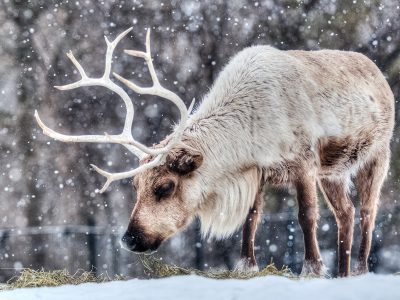Lead image by Shutterstock
By Jessica Robichaud
This article is republished from The Conversation under a Creative Commons licence. All photos provided by The Conversation from various sources.
Jessica Robichaud is a PhD Student in aquatic ecology at Carleton University.
Imagine it’s winter, and you’re standing on a frozen lake or pond, when suddenly below your feet you notice hundreds of turtles. What are they doing down there below the ice?
Freshwater turtles in temperate regions like Canada spend several months of the year braced against frigid winter conditions of temperatures around or below 0 C and the formation of ice on water bodies.
For all eight species of freshwater turtles in Canada, this ice barrier — and more importantly the liquid water below it — is a refuge from the freezing temperatures above. While ice coverage protects these turtles from the harsh cold, it also presents them with a challenge: restricted access to atmospheric oxygen.
Life under ice
Some species, like snapping turtles (Chelydra serpentina) and painted turtles (Chrysemys picta), are perfectly comfortable spending several months submerged in water depleted in oxygen. However, some species do not fare as well without oxygen and can only survive a few weeks at a time if submerged without adequate oxygen. These species need to extract the oxygen dissolved in the water to survive.

(Lucas Foerster/iNaturalist), CC BY
The northern map turtle (Graptemys geographica) is an example of such a species. They have also been observed engaging in locomotor activity — they keep moving around under the ice during the winter.
Northern map turtles were observed over a century ago by marine biologists Barton Warren Evermann and Howard Walton Clark.
During a dive at a communal hibernation site in November 1991 in Vermont, marine biologists observed map turtles walking across the bottom of a river before ice coverage when temperatures were dropping to near 0 C.
These observations lead us to believe that this behaviour may be important to a map turtle’s ability to survive the winter. Why else would they tap into their limited winter energy stores to move?
But how much do turtles really move in the winter?
Advances in technology
To track the movement of northern map turtles under the ice, our team glued tri-axial accelerometers — a type of biologging device that collects data — on 40 turtles at a known overwintering site in eastern Ontario. These devices recorded the movement, depth and temperature of the turtles for the seven months they remained under the ice.
Tri-axial accelerometers function similarly to a FitBit or Apple Watch — the devices produce a value called overall dynamic body acceleration. This number is a measure of how much each turtle moves on a daily basis.
Combining this information with measurements of depth and temperature, we were able to paint a detailed picture of each turtle’s behaviour without ever seeing them.

(Grégory Bulté), CC BY
Daily movement
Our findings surprised us. The data showed that northern map turtles move, albeit locally, every day of the winter. While that may look different across individuals, the interesting thing here is that movement is indeed continuous throughout the winter and not that different than in the weeks before the ice locks them in for the winter.
Although we expected some level of activity based on previous observations, we did not expect the turtles to be so fidgety all winter long.
Oxygen appears to be in short supply under the ice, and map turtles cannot live without it for very long, so one would expect them to take it easy to limit their oxygen consumption. Our devices also told us the turtles were milling about in water hovering around 1 C, a temperature at which most reptiles become uncontrollably lethargic.
Staying cool may in fact be what allows turtles to remain active. It’s likely that by staying at near-freezing temperatures, map turtles can slow their metabolic demands, thereby decreasing their need for oxygen and extending their use of this limited resource.
Implications of movement
We suspect that map turtles remain active in winter to meet their need for oxygen in order to survive the winter. Small amounts of activity may allow this species to replace the oxygen-depleted boundary layer of water on their skin with freshly oxygenated water. This would enhance their ability to “breathe” through their skin.
Alternatively, movement may be necessary for turtles as they look for micro-climates within their environment that have higher concentrations of oxygen or preferred temperature and depth profiles. In doing so, map turtles may be able to better need their physiological needs and oxygen requirements through the entirety of winter.
Much of what we know about reptiles in temperate regions is based on research done during the months which they are conspicuous. We are thus missing out on a big chunk of their annual cycle. As global temperatures continue to change, it is increasingly important to understand the winter part of a reptile’s lifecycle so we can plan how climate change may impact these animals.
![]()
Monday, August 28, 2023 in The Conversation
Share: Twitter, Facebook



